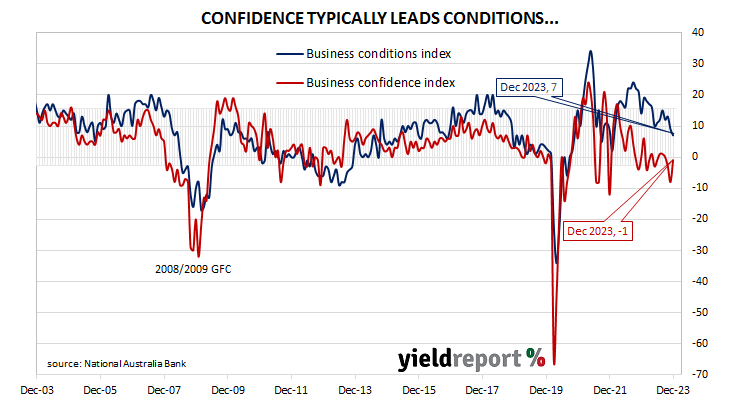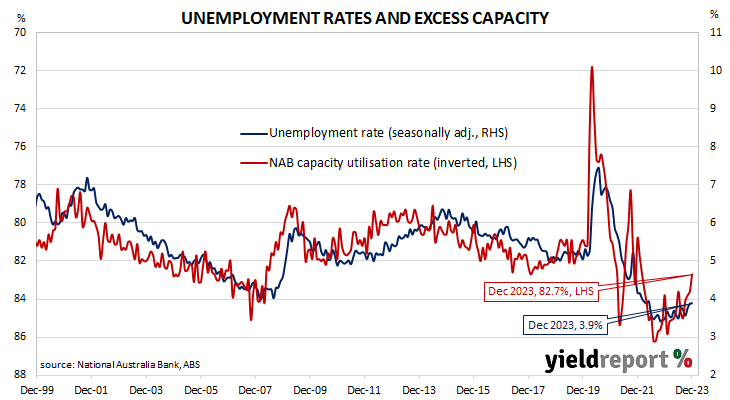Summary: Business conditions deteriorate in December; business pessimism lessens but well below average; decline in conditions led by manufacturing, construction; ACGB yields fall; rate-cut expectations harden; consumers cutting back on spending, although confidence in retail sector “encouraging”; capacity utilisation rate declines, still at elevated level.
NAB’s business survey indicated Australian business conditions were robust in the first half of 2018, with a cyclical-peak reached in April of that year. Readings from NAB’s index then began to slip and forecasts of a slowdown in the domestic economy began to emerge in the first half of 2019 as the index trended lower. It hit a nadir in April 2020 as pandemic restrictions were introduced but then improved markedly over the next twelve months and has subsequently remained at robust levels.
According to NAB’s latest monthly business survey of around 500 firms conducted in first half of January, business conditions have deteriorated again, albeit to a level which about average. NAB’s conditions index registered 7 points, down 2 points from November’s reading.
“The decline in conditions was led by manufacturing and construction. Elsewhere, conditions remained weak in retail but remained elevated in the services sectors,” said NAB senior economist Brody Viney.
Business confidence improved markedly after deteriorating for three consecutive months. NAB’s confidence index rose from November’s revised reading of -8 points to -1 point, although it is still well below the long-term average. Typically, NAB’s confidence index leads the conditions index by one month, although some divergences have appeared from time to time.
Commonwealth Government bond yields fell on the day. By the close of business, the 3-year ACGB yield had shed 5bps to 3.76%, the 10-year yield lost 4bps to 4.21% while the 20-year yield finished 3bps lower at 4.51%.
In the cash futures market, expectations regarding rate cuts later this year hardened. At the end of the day, contracts implied the cash rate would remain close to the current rate for the next few months and average 4.32% through February, 4.31% in March and 4.295% in April. However, August contracts implied a 4.14% average cash rate while November contracts implied 3.985%, 33bps less than the current rate.
“Overall, both confidence and conditions are softest in manufacturing, retail and wholesale which reflects that consumers have been cutting back on spending as time has gone on,” said NAB Chief Economist Alan Oster. “There was an encouraging pickup in confidence in the retail sector in December, but it remains to be seen if this will be maintained.”
NAB’s measure of national capacity utilisation declined again, from November’s revised reading of 83.6% to 82.7%, a level which is still elevated from a historical perspective. Seven of the eight sectors of the economy were reported to be operating at or above their respective long-run averages.
Capacity utilisation is generally accepted as an indicator of future investment expenditure and it also has a strong inverse relationship with Australia’s unemployment rate.



